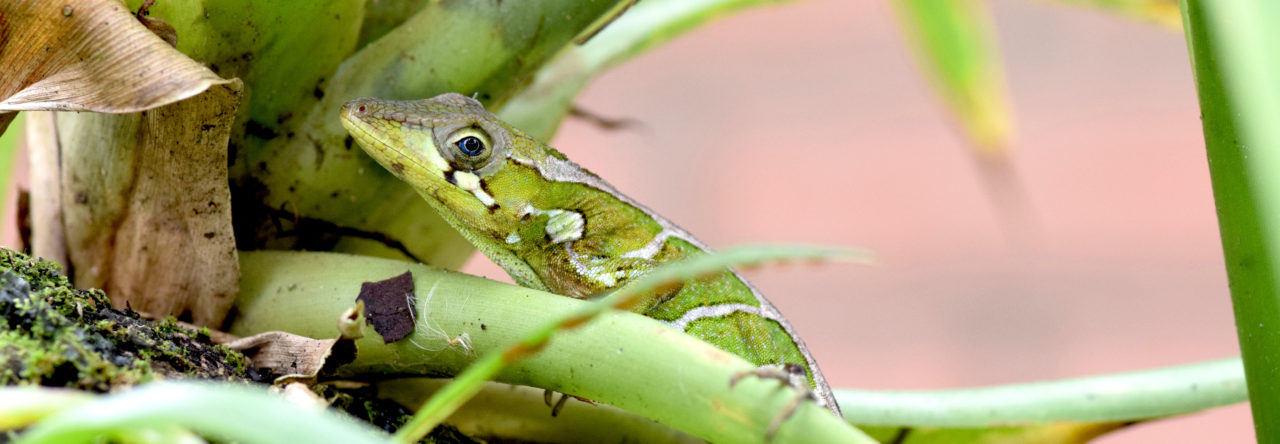Several previous posts have discussed the odd case of Anolis lineatus on Curaçao, whose dewlap differs from one side to the other. Rand and Rand reported this in 1967, but the observation was pretty much forgotten until earlier this year, when Matt Brandley and compatriots confirmed the Rands’ claim. Shortly thereafter, Melissa Losos and I travelled to Curaçao as well and observed the same phenomenon, allaying concerns that the Brandley team was covering for the Rands.
But since these posts, many AA readers have no doubt been sleepless at night, pondering the obvious question: what about A. lineatus on Aruba? Do they, too, have mismatched throat fans? Indeed, one could imagine a scenario in which they might not. Asymmetry is a common result of low levels of genetic variation (although there is a lot of quibbling about this in the literature). Curaçao is downstream in an ocean current sense from Aruba. Thus, it could be that the Curaçao population of A. lineatus was founded by one or few Arubians, and thus the resulting founder effect gave rise to the dewlap discordance.
An exciting hypothesis that I am pleased to immediately quash: Anolis lineatus on Aruba have asymmetric dewlaps just as their brethren on Curaçao, and the asymmetry arises just as Brandley reported.
On one side of the dewlap, and one side only, along the outer margin, there are many large white scales, giving the dewlap a yellowish appearance when viewed from a distance, whereas on the other side, a paucity of scales lets the orange shine through unfettered. This asymmetry appears to occur in both males and females and shows no obvious directionality, the white scales occurring on the left side in some lizards and the right in others.
Now for more matters Arubian: as far as I can tell, there is basically nothing in the literature on the natural history of A. lineatus on Aruba. Field guides suggest that the populations are extremely similar, with perhaps slight color and patterning differences, and I can attest that that this is so. The Aruban lizards, however, seemed substantially larger—males to 83 svl on Aruba versus 76 on Curaçao—but this is based on a geographically limited sample on both islands.
Ecologically, A. lineatus on Aruba are like their counterparts. The more I saw them, the more I was convinced they are good trunk-ground anoles: muscular lizards, with long hindlegs, even a bit of a tail crest, like some A. sagrei (not as grand as the Puerto Rican crested anoles). Ecologically, they were very common on large tree trunks and rocks, usually a meter off the ground at most, though occasionally a bit higher. Only a few were seen up in the trees. In addition, in some places on both islands, they are extremely common, just as trunk-ground anoles often are.
The trunk-ground nature of A. lineatus is unexpected, as in the Lesser Antilles, solitary anoles (i.e., anoles living on an island with no other anole species) are almost almost very similar to trunk-crown anoles, both in terms of morphology and habitat. Why this species on these two islands bucks this trend would make a good study. One possibility is that A. lineatus is derived from the chrysopelis clade, which contains species all of which are more or less terrestrial. Another possibility has to do with the extremely arid—downright desert-like in places—climate on these islands.
One last note: for all you anole neophytes. Anolis lineatus is about the easiest anole to noose that ever existed. They sit right out in the open, on big, unobstructed perches, and hardly move as a noose is lowered over their head. A great starter anole, and you can celebrate by hitting the casinos in Aruba or sipping a Blue Lagoon, made from the eponymous curaçao liquer.
- Evolution in Real Time on Lizard Island - March 23, 2025
- Spider Snags Adult Anolis osa - March 22, 2025
- An Homage to the Green Anoles of New Orleans - March 21, 2025




Gabriel Ugueto
Very interesting. It would also seem to me that the dark spot on the base of the dewlap is darker in the Curaçao specimen than in the Aruban one. Is this true for all specimens? It would not surprise me one bit if the Curaçao and Aruban populations differed. Both islands along with Bonaire and the Venezuelan Antilles have never been connected to each other or to the continental mainland.
Jonathan Losos
Interesting observation. We have a bunch of photos from lizards from the two islands and will compare them. I agree that it’s not too suprising for them to differ–I wonder how long the populations have been separated.
cybokat
I know I’m late to the party but I just randomly found this study here on asymmetry of secondary sexual displays in Scleroporus.. if anyone is interested..
http://csuchico-dspace.calstate.edu/bitstream/handle/10211.4/113/5%2030%202009%20Jackson%20Shedd.pdf?sequence=1
Tim
One thing: the ocean flows from east to west on our islands. From Bonaire, to Curacao, to Aruba. Just like the prevailing tradewinds. E few weeks ago a diver drowned here on Curacao, to be found a few days later on Aruba’s north shore.